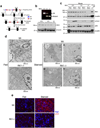Identification of ROCK1 kinase as a critical regulator of Beclin1-mediated autophagy during metabolic stress
- PMID: 23877263
- PMCID: PMC3740589
- DOI: 10.1038/ncomms3189
Identification of ROCK1 kinase as a critical regulator of Beclin1-mediated autophagy during metabolic stress
Abstract
The Ser/Thr Rho kinase 1 (ROCK1) is known to have major roles in a wide range of cellular activities, including those involved in tumour metastasis and apoptosis. Here we identify an indispensable function of ROCK1 in metabolic stress-induced autophagy. Applying a proteomics approach, we characterize Beclin1, a proximal component of the phosphoinositide 3-kinase class III lipid-kinase complex that induces autophagy, as an interacting partner of ROCK1. Upon nutrient deprivation, activated ROCK1 promotes autophagy by binding and phosphorylating Beclin1 at Thr119. This results in the specific dissociation of the Beclin1-Bcl-2 complex without affecting the Beclin1-UVRAG interaction. Conversely, inhibition of ROCK1 activity increases Beclin1-Bcl-2 association, thus reducing nutritional stress-mediated autophagy. Genetic knockout of ROCK1 function in mice also leads to impaired autophagy as evidenced by reduced autophagosome formation. These results show that ROCK1 acts as a prominent upstream regulator of Beclin1-mediated autophagy and maintains a homeostatic balance between apoptosis and autophagy.
Figures







References
Publication types
MeSH terms
Substances
Grants and funding
- CAPMC/ CIHR/Canada
- DK43351/DK/NIDDK NIH HHS/United States
- R01 DK083567/DK/NIDDK NIH HHS/United States
- P01 CA080058/CA/NCI NIH HHS/United States
- P30 DK057521/DK/NIDDK NIH HHS/United States
- CA149477/CA/NCI NIH HHS/United States
- R01 CA140615/CA/NCI NIH HHS/United States
- R01 CA127247/CA/NCI NIH HHS/United States
- CA140615/CA/NCI NIH HHS/United States
- R01 CA149477/CA/NCI NIH HHS/United States
- DK083567/DK/NIDDK NIH HHS/United States
- P30 DK043351/DK/NIDDK NIH HHS/United States
- CA127247/CA/NCI NIH HHS/United States
- DK57521/DK/NIDDK NIH HHS/United States
LinkOut - more resources
Full Text Sources
Other Literature Sources
Molecular Biology Databases
Research Materials

